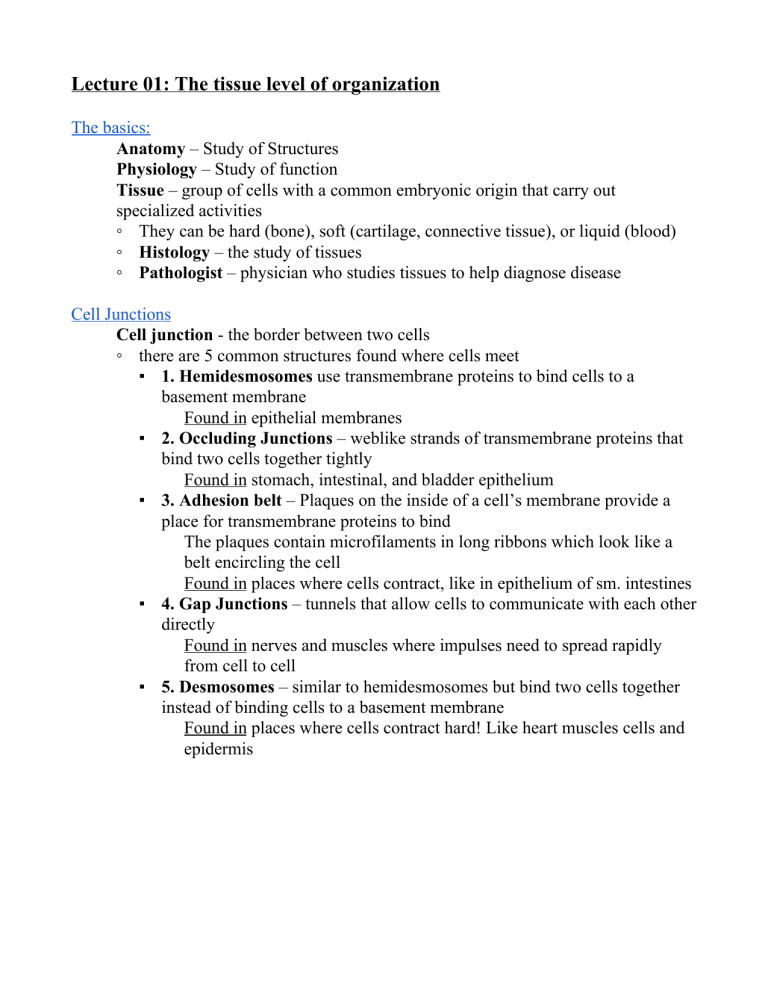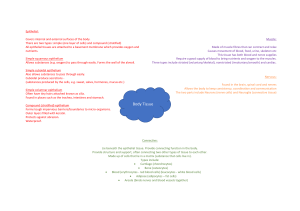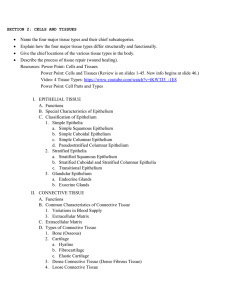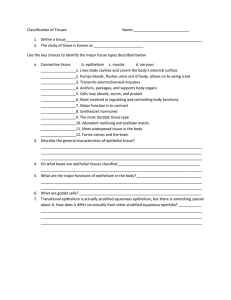
Lecture 01: The tissue level of organization The basics: Anatomy – Study of Structures Physiology – Study of function Tissue – group of cells with a common embryonic origin that carry out specialized activities ◦ They can be hard (bone), soft (cartilage, connective tissue), or liquid (blood) ◦ Histology – the study of tissues ◦ Pathologist – physician who studies tissues to help diagnose disease Cell Junctions Cell junction - the border between two cells ◦ there are 5 common structures found where cells meet ▪ 1. Hemidesmosomes use transmembrane proteins to bind cells to a basement membrane Found in epithelial membranes ▪ 2. Occluding Junctions – weblike strands of transmembrane proteins that bind two cells together tightly Found in stomach, intestinal, and bladder epithelium ▪ 3. Adhesion belt – Plaques on the inside of a cell’s membrane provide a place for transmembrane proteins to bind The plaques contain microfilaments in long ribbons which look like a belt encircling the cell Found in places where cells contract, like in epithelium of sm. intestines ▪ 4. Gap Junctions – tunnels that allow cells to communicate with each other directly Found in nerves and muscles where impulses need to spread rapidly from cell to cell ▪ 5. Desmosomes – similar to hemidesmosomes but bind two cells together instead of binding cells to a basement membrane Found in places where cells contract hard! Like heart muscles cells and epidermis 4 types of tissues: Epithelial tissue Connective tissue Muscle tissue Nervous tissue Epithelial tissue : A flat covering that covers the body in sheets, lines organs and cavities Cells closely paced, held tightly together Always have one free (apical) surface and one bound (basal) surface 4 Major functions ◦ 1. provide physical protection ◦ 2. control permeability (e.g. act like a filter) ◦ 3. provide sensation (e.g. the feeling of touch, heat, cold etc) ◦ 4. provide specialized secretions (e.g. sweat, sebum, etc) surfaces ◦ 1. Apical surface: the top ▪ the top, it is often facing a lumen (internal space) or facing the exterior of the body ▪ often covered in cilia or microvilli (tiny hairlike projections) ◦ 2. basolateral surfaces: the bottom and sides ▪ the basal surface is where the cell attaches to the basal lamina basal lamina: a complex structure made by the epithelial cells and the connective tissue below them the basal lamina has two layers ◦ 1. clear layer ◦ 2. dense layer Epithelial tissue has nerves, but is avascular (it has no blood vessels) ◦ Blood is supplied by the underlying connective tissue Epithelial tissue divides rapidly so that it is always being renewed and repaired Epithelium can be classified in two major ways – ◦ 1. By the number of layers ▪ Simple – a single layer Function in diffusion, osmosis, filtration, or absorption ▪ Pseudostratified – a single layer that looks like it has several layers (but it doesn’t) Nuclei are at different levels so it has a stratified appearance ▪ Stratified – many layers to provide protection to underlying tissues ◦ 2. By the shape of the cells it is composed of ▪ Squamous – Flat cells Allows for rapid passage or substances ▪ Cuboidal – cube shaped cells May have microvilli Function in secretion or absorption ▪ Columnar – column shaped May have cilia or microvilli Function in secretion or absorption ▪ Transitional – cells can change shape! Exist in the bladder where things stretch considerably Examples of Squamous epithelium ◦ Simple squamous epithelium ▪ Single layer, arranged like floor tiles ▪ Nucleus is centrally located ▪ Found at sites of filtration (kidneys), and diffusion (air sacs in lungs) ◦ Stratified squamous epithelium ▪ Several layers, that are flat in the apical layer ▪ New cells are made and pushed up where they dehydrate, darken, and die ▪ Can be keratinized (skin) or non-keritinized (mouth & esophagus) Examples of Cuboidal epithelium... ◦ Simple cuboidal epithelium ▪ Single layer, cube shaped cells ▪ Nucleus centrally located ▪ Found in thyroid gland (secretion) and kidneys (absorption) ◦ Stratified cuboidal epithelium ▪ Apical layers are cuboidal ▪ Rare, found in sweat glands and esophageal glands Example of Transitional epithelium... ◦ Transitional epithelium ▪ when relaxed cells are cuboidal, when stretched cells are squamous ▪ Found in bladder, and in urine collecting chambers in kidneys Examples of columnar epithelium... ◦ Simple columnar epithelium ▪ Single layer, column shaped non-ciliated – no cilia, have microvilli instead ◦ secrete mucus via goblet cells ◦ line digestive, reproductive, & urinary tracts ciliated – have cilia ◦ also secrete mucus via goblet cells ◦ line respiratory tract (ciliary escalator) ◦ Pseudostratified columnar epithelium ▪ Appears to have several layers, but all cells attached to basement membrane ▪ Ciliated – secrete mucus (with goblet cells) ▪ Non-ciliated – lack goblet cells ◦ Stratified columnar epithelium ▪ Apical layers are columnar ▪ Also rare, found in esophagus, urethra, conjunctiva of eye Epithelium can be divided into two major types: ◦ 1. Covering and lining epithelium ▪ e.g. like the skin or the lining of internal organs ▪ can be classified in two major ways, layer arrangements, and cell ◦ 2. Glandular epithelium ▪ The parts of glands that secrete things (like hormones, sweat, oil, etc.) ▪ Two types of glands Endocrine – secrete hormones directly into the bloodstream ◦ Example: thyroid gland Exocrine – secrete products (mucus, sweat, oil, earwax, saliva, etc) into ducts ◦ Example: sweat glands Connective tissue Acts like “insulating glue” Protects, supports, binds tissues together, and stores energy Supplied with nerves just like epithelium, but unlike epithelium, C.T. is highly vascular (exception: cartilage and tendons) Most abundant & widely distributed tissues in the body Consists of cells and extracellular matrix (the stuff located between cells) ◦ Most of the time, there is a lot of matrix (exception: adipose tissue) ◦ Often, the matrix is the basis for classifying the tissue ◦ 3 major types of fibers in the extracellular matrix ▪ collagen fibers – very strong & thick, but not very stretchy found in most types of C.T. (especially in bone, cartilage, tendons, and ligaments) ▪ reticular fibers – thin, strong, and form branching networks found in framework of many soft organs (like spleen & lymph nodes) ▪ elastic fibers – thin, unbranching, & very stretchy found in skin, blood vessel walls, lung tissue ◦ the extracellular matrix that isn’t fibers is called ground substance ▪ can be fluid, semi-fluid, gelatinous, or calcified Classifying connective tissues ◦ 5 Major kinds ▪ 1. Loose connective tissue – comes in three varieties Areolar C.T. ◦ Most widely distributed tissue in the body ◦ Contains all three fiber types ◦ Located in subcutaneous layer of skin, many organs Adipose Tissue ◦ Contains fat cells (adipocytes) ◦ Insulates body and stores energy Reticular Connective Tissue ◦ Fine interlaced reticular fibers and cells ◦ Forms stroma of liver, spleen, & lymph nodes ▪ 2. Dense connective tissue – heals poorly due to minimal blood supply Very fibrous, collagen fibers are packed closely together Fewer cells than loose connective tissue Three types: ◦ Dense regular connective tissue – bundles of fibers are arranged in parallel ▪ Appears wavy, make up tendons & most ligaments ◦ Dense irregular connective tissue – fibers are irregularly arranged ▪ Found in dermis of skin and heart, where pulling forces exerted in many different directions ◦ Elastic connective tissue – contain branching elastic fibers ▪ Found in lung tissue and arteries ▪ 3. Fluid connective tissue Blood – the stuff in your veins & arteries ◦ Composed of red blood cells, white blood cells, platelets, and plasma (the liquid portion & extracellular matrix lymph (more on this stuff in A&P2) ▪ 4. Cartilage – dense network of collagen fibers and elastic fibers in ground substance no blood vessels or nerves – means that cartilage repairs slowly Chondrocytes – cells found in spaces called lacunae Cartilage is surrounded by a membrane called pericondrium which contains all of the blood vessels needed to nourish the cartilage Three types ◦ Hyaline cartilage – most abundant cartilage in the body ▪ Provides flexibility & support, reduces friction ▪ Located at the ends of long bones, nose, larynx, trachea ◦ Elastic Cartilage – contains elastic fibers ▪ Most flexible cartilage type ▪ Found in pinna of ear, epiglottis ◦ Fibrocartilage – strongest type of cartilage ▪ Found in intervertebral discs in spine, pubic symphysis ▪ 5. Bone tissue – the tough stuff that muscles pull on Provide support for your entire body (more on this stuff later this semester) Muscular tissue Consists of elongated cells called muscle fibers Generates physical forces, produce heat ◦ Three types ▪ 1. Skeletal Attached to bones, have striations, used for voluntary movement ▪ 2. Cardiac Make up the heart, have striations & intercalated discs ▪ 3. Smooth Spindle shaped, non-striated, not under voluntary control Found in iris of eyes, small intestine, uterus, blood vessels Nervous tissue Send information very fast because of electrical excitability ◦ Information travels in waves called action potentials (APs) ▪ APs propagate along nerves to other nerves or muscles ◦ Two types ▪ 1. Neurons (send the signals) ▪ 2. Neuroglia (tend to neurons, neuron nannies) ◦ Basically the raddest stuff ever Tissue Repair: Tissue heals faster in young adults Surgery of a fetus normally leaves no scars ◦ Young tissues have a better nutritional state, blood supply, and higher metabolic rate ▪ Blood flow can be increased by exercise ◦ Breakdown & loosening of collagen and elastic fibers contribute to aging process







